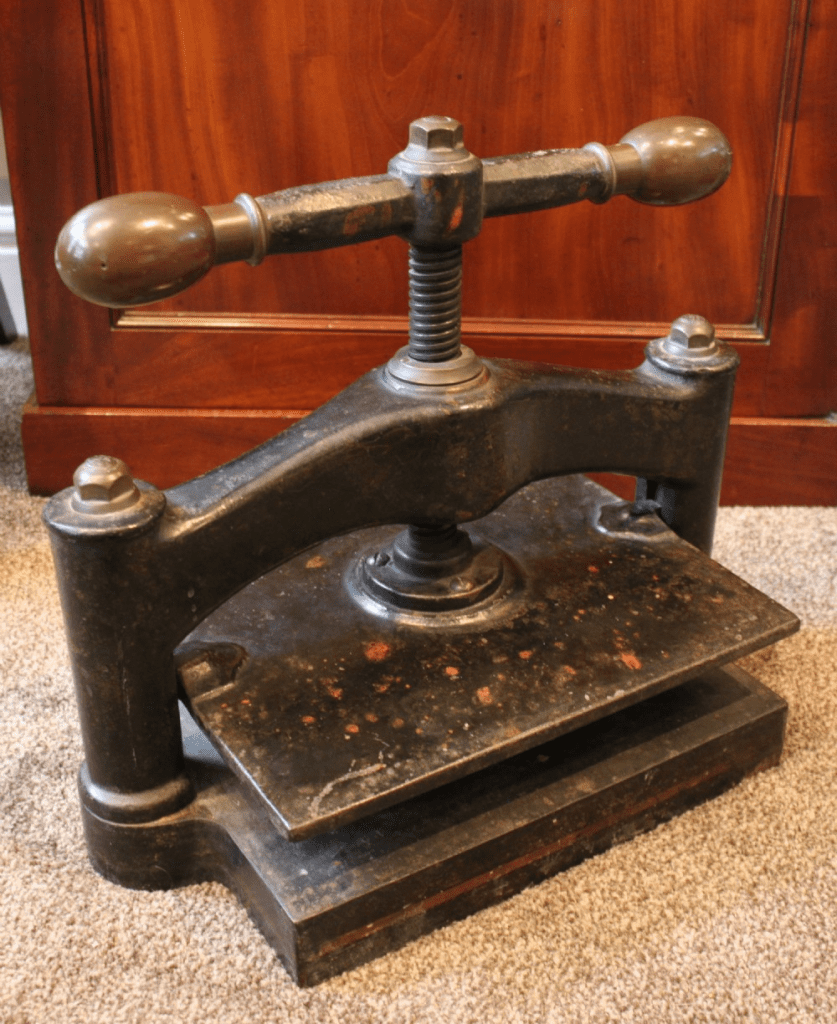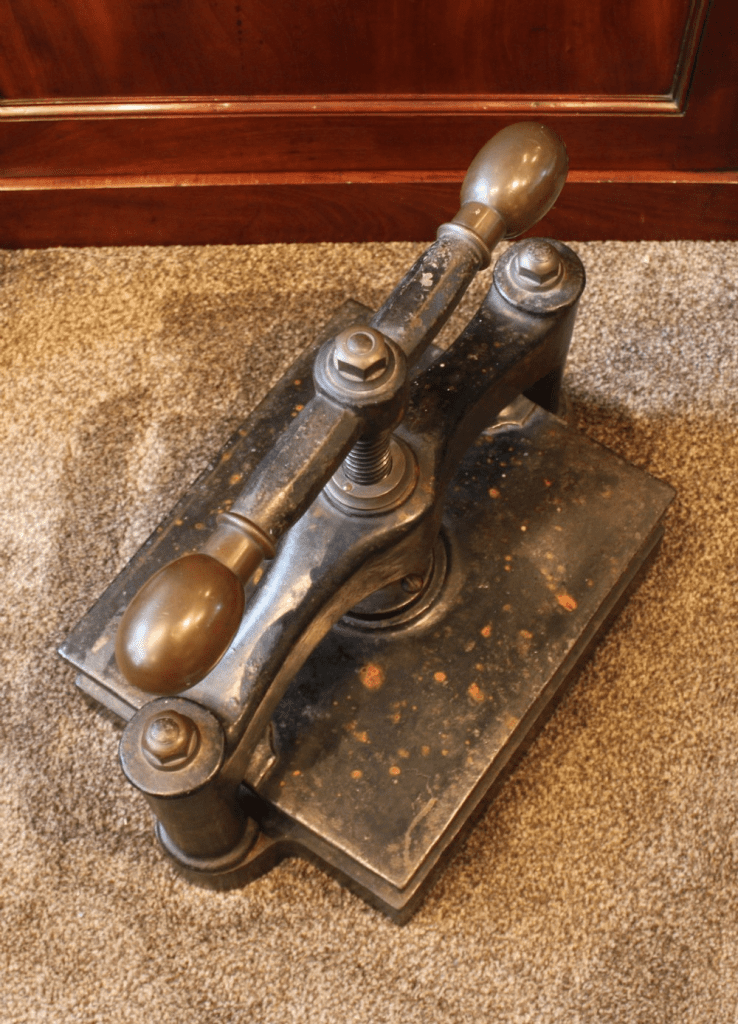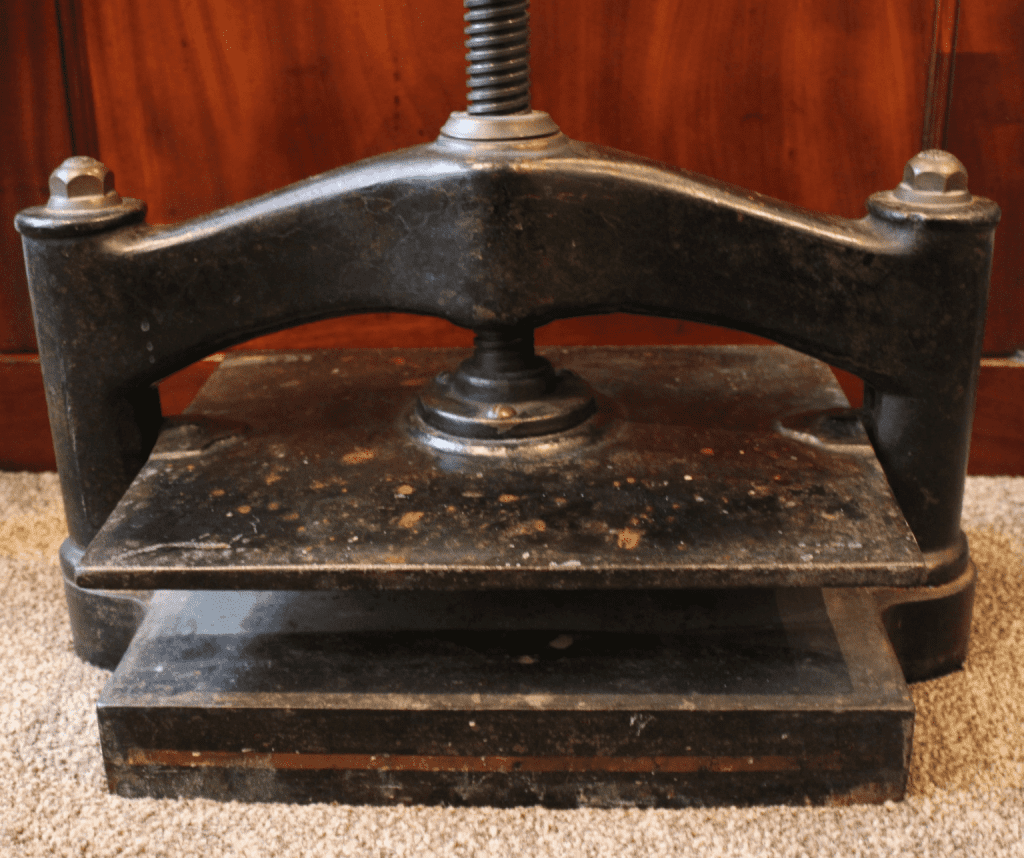In a world that increasingly relies on digital technology, there’s a growing fascination with objects from the past—items that symbolize a time when craftsmanship and precision were prized above all else. One such item that has captured the imagination of collectors and enthusiasts alike is the vintage cast iron book press. This piece of history not only reflects the intricate art of bookbinding but also serves as a testament to the Industrial Revolution’s impact on printed materials. Let’s dive into the fascinating history, usage, and legacy of this highly sought-after relic.

A Glimpse into History: The Rise of the Cast Iron Book Press
The vintage cast iron book press first appeared in the 19th century, at a time when bookbinding was an essential craft. As the Industrial Revolution progressed, the demand for books surged, necessitating tools that could withstand rigorous use while providing consistent quality. Enter cast iron—a material chosen for its unparalleled strength and durability.
These presses revolutionized the process of bookbinding, allowing artisans to apply even pressure to books during production. The resulting bound books were sturdy, symmetrical, and aesthetically pleasing. The book press was also highly versatile, finding its place not only in bookbinding workshops but also in printmaking studios and even homes, where it was used for tasks such as flattening documents and pressing flowers.
The Versatility of the Cast Iron Book Press
While primarily designed for bookbinding, the cast iron book press quickly became an indispensable tool for various tasks. Here are just a few of the ways it was used:
1. Binding Books with Precision
At its core, the cast iron book press was designed to provide uniform pressure on books during the binding process. After pages were sewn together, the book press ensured that the binding adhered properly and that the book’s shape was retained. This careful pressure also helped prevent the pages from warping, ensuring that books had a long shelf life.
2. Pressing Flowers for Art and Keepsakes
Interestingly, the book press found a second life outside of bookbinding in the practice of flower pressing. Artists and hobbyists alike used these sturdy devices to flatten and dry flowers, preserving their beauty in perfect detail. The even pressure allowed delicate flowers to be preserved for years, making them popular for framing or inclusion in personal keepsakes.
3. Flattening and Embossing Documents
For those in need of perfectly flat documents or papers, the cast iron book press was ideal. It could flatten sheets, removing any creases or wrinkles, making it an invaluable tool in print shops. Additionally, some book presses were used to emboss designs onto book covers, adding intricate details and artistic flourishes that elevated the quality of the finished product.
Why Collectors Crave the Vintage Cast Iron Book Press
Today, the vintage cast iron book press holds a special allure for collectors and history buffs. But what makes this item so desirable?
1. A Symbol of Craftsmanship and Tradition
In an age of mass production, the vintage book press serves as a reminder of the time when books were meticulously crafted by hand. The intricate design of these presses showcases the skill and dedication of the artisans who once used them. Collectors appreciate the mechanical ingenuity that made these tools so effective, as well as their historical significance in the evolution of printed materials.

2. Aesthetic Appeal for Homes and Libraries
Aside from its historical value, the vintage cast iron book press also appeals to those who admire industrial design. With their robust, intricate construction, these presses are often displayed as statement pieces in homes, libraries, and museums. Their ornate details and imposing presence make them not just functional tools but also works of art that blend history with decoration.
3. A Testament to Durability and Ingenuity
The durability of cast iron ensures that many of these presses have survived for over a century, often in excellent condition. This resilience, combined with the mechanical simplicity of the press, adds to its allure. Unlike modern machinery that may require constant upkeep or eventual replacement, these vintage presses were built to last—a testament to the quality of 19th-century engineering.
Preserving the Legacy of Bookbinding
While modern technology has made manual bookbinding and book presses largely obsolete, the legacy of the vintage cast iron book press endures. Bookbinders, historians, and collectors cherish these presses not only for their craftsmanship but for what they represent—a connection to a time when books were made with care, intention, and pride.

Today, some artisans still use these presses to create hand-bound books, combining modern techniques with traditional methods. In doing so, they preserve the heritage of bookbinding, ensuring that the skills and tools of the past are not lost to history.
The Future of Vintage Cast Iron Book Presses
As more people seek to reconnect with tangible, well-crafted objects from the past, the vintage cast iron book press continues to grow in popularity. Its nostalgic charm appeals to a wide range of enthusiasts, from antique collectors to those who simply appreciate the beauty of traditional craftsmanship.
While the digital age has largely replaced the need for such presses in book production, their legacy lives on through the passion of collectors and the preservation efforts of museums. The vintage cast iron book press is more than just a tool—it’s a symbol of human ingenuity and the enduring power of the printed word.

Conclusion: A Timeless Relic Worthy of Admiration
The vintage cast iron book press is much more than an antique object. It represents a rich history of craftsmanship, innovation, and the value of the written word. Whether admired for its functional role in bookbinding or its striking appearance as a decorative piece, the cast iron book press is a reminder of a time when books were treasured and made with care. In today’s fast-paced world, owning a piece of this history feels like holding a piece of the past, a relic that continues to inspire awe and admiration for generations to come.


